Related Research Articles

The history of China spans several millennia across a wide geographical area. Each region now considered part of the Chinese world has experienced periods of unity, fracture, prosperity, and hardship. Classical Chinese civilization first emerged in the Yellow River valley, which along with the Yangtze and Pearl River basins now constitute the geographic core of China and have for the majority of its imperial history. China maintains a rich diversity of ethnic and linguistic people groups. The traditional lens for viewing Chinese history is the dynastic cycle: imperial dynasties rise and fall, and are ascribed certain achievements. Throughout pervades the narrative that Chinese civilization can be traced as an unbroken thread many thousands of years into the past, making it one of the cradles of civilization. At various times, states representative of a dominant Chinese culture have directly controlled areas stretching as far west as the Tian Shan, the Tarim Basin, and the Himalayas, as far north as the Sayan Mountains, and as far south as the delta of the Red River.
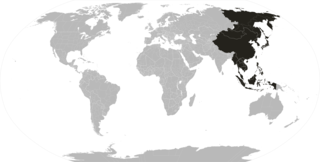
The Far East is the geographical region that encompasses the easternmost portion of the Asian continent, including East, North and Southeast Asia. South Asia is sometimes also included in the definition of the term.
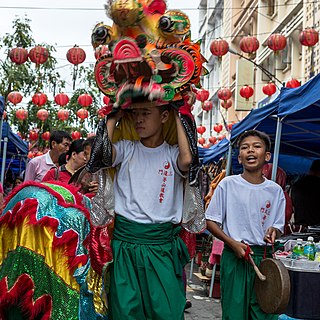
The Hakka, sometimes also referred to as Hakka Han, or Hakka Chinese, or Hakkas, are a Han Chinese subgroup whose ancestral homes are chiefly in the Hakka-speaking provincial areas of Guangdong, Fujian, Jiangxi, Guangxi, Sichuan, Hunan, Zhejiang, Hainan, and Guizhou in China, as well as in Taoyuan City, Hsinchu County, Miaoli County, Pingtung County, and Kaohsiung City in Taiwan. The Chinese characters for Hakka literally mean "guest families". Unlike other Han Chinese subgroups, the Hakkas are not named after a geographical region, e.g. a province, county or city, in China. The word Hakka or "guest families" is Cantonese in origin and originally refers to the Northern Chinese migrants fleeing social unrest, upheaval and invasions in northern parts of China during the Qing dynasty who then sought sanctuary in the Cantonese provinces such as Guangdong and Guangxi, thus the original meaning of the word implies that they are guests living in the Cantonese provinces. Over the centuries, they have since more or less assimilated with the Cantonese people. Modern day Hakka are generally identified by both full Hakka and by different degrees of Hakka ancestry and usually speak Hakka Chinese.
Sinology, otherwise referred to as Chinese studies, is a sub-field of area studies or East Asian studies involved in social sciences and humanities research on China. It is an academic discipline that focuses on the study of the Chinese civilization primarily through Chinese language, history, culture, literature, philosophy, art, music, cinema, and science. Its origin "may be traced to the examination which Chinese scholars made of their own civilization."
Westernization, also Europeanisation or occidentalization, is a process whereby societies come under or adopt what is vaguely considered to be Western culture, in areas such as industry, technology, science, education, politics, economics, lifestyle, law, norms, mores, customs, traditions, values, mentality, perceptions, diet, clothing, language, writing system, religion, and philosophy. During colonialism it often involved the spread of Christianity.
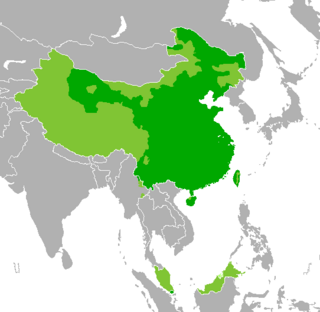
Sinophone, which means "Chinese-speaking", typically refers to an individual who speaks at least one variety of Chinese. Academic writers often use the term Sinophone in two definitions: either specifically "Chinese-speaking populations where it is a minority language, excluding Mainland China, Hong Kong, Macau, and Taiwan" or generally "Chinese-speaking areas, including where it is an official language". Many authors use the collocation Sinophone world or Chinese-speaking world to mean the Chinese-speaking world itself or the distribution of the Chinese diaspora outside of Greater China.
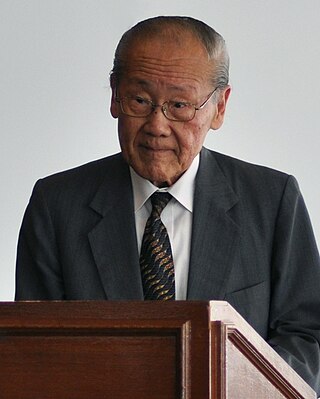
Wang Gungwu, is an Australian historian, sinologist, and writer specialising in the history of China and Southeast Asia. He has studied and written about the Chinese diaspora, but he has objected to the use of the word diaspora to describe the migration of Chinese from China because both it mistakenly implies that all overseas Chinese are the same and has been used to perpetuate fears of a "Chinese threat", under the control of the Chinese government. An expert on the Chinese tianxia concept, he was the first to suggest its application to the contemporary world as an American Tianxia.

The chi is a traditional Chinese unit of length. Although it is often translated as the "Chinese foot", its length was originally derived from the distance measured by a human hand, from the tip of the thumb to the tip of the forefinger, and is similar to the ancient span. It first appeared during China's Shang dynasty approximately 3,000 years ago and has since been adopted by other East Asian cultures such as Japan (shaku), Korea (ja/cheok), and Vietnam (thước). Its present value is standardized at around one-third metre, although the exact standards vary among the mainland of the People's Republic of China, its special administrative region of Hong Kong, and Taiwan.

The Cantonese people or Yue people, are a Yue-speaking ethnic group or Han Chinese subgroup originating from or residing in the provinces of Guangdong and Guangxi, in Southern Mainland China. More accurately, "Cantonese" refers only to people with roots from Guangzhou and its satellite cities and towns, rather than simply and generally referring to the people of the Liangguang region.

The Sinosphere, also known as the East Asian cultural sphere, or the Sinic world, encompasses multiple countries in East Asia and Southeast Asia that historically were heavily influenced by Chinese culture, norms and traditions. According to academic consensus, the Sinosphere comprises four entities: Greater China, Japan, Korea, and Vietnam. Other definitions may include Mongolia and Singapore, largely due to limited historical Chinese influences or increasing modern-day Chinese diaspora. The Sinosphere is not to be confused with Sinophone, which indicates countries where a Chinese-speaking population is dominant.
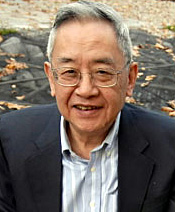
Yu Ying-shih was a Chinese-born American historian, sinologist, and the Gordon Wu '58 Professor of Chinese Studies, Emeritus, at Princeton University. He was known for his mastery of sources for Chinese history and philosophy, his ability to synthesize them on a wide range of topics, and for his advocacy for a new Confucianism. He was a tenured professor at Harvard University and Yale University before his time at Princeton.
De-Sinicization is a process of eliminating or reducing Chinese cultural elements, identity, or consciousness from a society or nation. In modern contexts, it is often used in tandem with decolonization and contrasted to the assimilation process of Sinicization.

Ch'ien Mu or Qian Mu was a Chinese historian, philosopher and writer. He is considered to be one of the greatest historians and philosophers of 20th-century China. Ch'ien, together with Lü Simian, Chen Yinke and Chen Yuan, was known as the "Four Greatest Historians" of Modern China (現代四大史學家).

The economy of East Asia comprises 1.6 billion people living in six different countries and regions. The region includes several of the world's largest and most prosperous economies: Japan, South Korea, China, Taiwan, Hong Kong, and Macau. It is home to some of the most economically dynamic places in the world, being the site of some of the world's most extended modern economic booms, including the Japanese economic miracle (1950–1990), Taiwan miracle in Taiwan, (1960–1996)Miracle on the Han River (1961–1996) in South Korea and the Chinese economic miracle (1978–2015) in mainland China.
China Circle refers to the economic relationship between mainland China, Hong Kong, and Taiwan. With the fast-growing economy and the development of foreign investment in China, China has become the centre of the Asian market in the 1980s. The production chain in Taiwan and Hong Kong soon merged in China and formed a new economic network named "the Circle of China".

East Asia is a region of Asia, which is defined in both geographical and ethno-cultural terms. The modern states of East Asia include China, Japan, Mongolia, North Korea, South Korea, and Taiwan. Hong Kong and Macau, two small coastal cities located in the south of China, are autonomous regions under Chinese sovereignty. Japan, Taiwan, South Korea, China, Hong Kong, and Macau are some of the world's largest and most prosperous economies. East Asia borders Siberia and the Russian Far East to the north, Southeast Asia to the south, South Asia to the southwest, and Central Asia to the west. To the east is the Pacific Ocean and to the southeast is Micronesia.
The Chiang Ching-kuo Foundation for International Scholarly Exchange is a private nonprofit organization located in Taipei, Taiwan, that provides support for research grants on Chinese studies in the humanities and social sciences at overseas institutions. It was founded in 1989 and named after Chiang Ching-kuo, the late President of the Republic of China from 1972 to 1988. The foundation also has a regional office in McLean, Virginia in the United States.
"A Manifesto for a Re-appraisal of Sinology and Reconstruction of Chinese Culture" is an essay originally published in China and Taiwan in 1958. The essay's collective authors included Carsun Chang, Tang Chun-I, Mou Tsung-san, and Hsu Fo-kuan, all “New Confucianism” scholars and notable students of Xiong Shili.
Taiwan studies, or Taiwanese studies, is a multi-disciplinary academic division of area studies focused on studying Taiwan and the people on/in/of Taiwan both on its own and in comparison with other world areas. Academia Sinica, Taiwan's national level research institute, officially inaugurated its Institute of Taiwan History in 2004 following a long exploratory period beginning in 1986. Taiwan studies departments and centers have been established in numerous universities around the world and key Taiwan studies organizations have been established in North America (NATSA), Europe, and Japan. The first World Congress of Taiwan Studies (WCTS) was hosted by Taiwan's Academia Sinica on April 26–28, 2012, in Taipei, Taiwan. More recently, China has begun to establish its own controversial version of Taiwan studies in the United States via its Confucius Institutes.
Chih-yu Shih is a political science professor in Taiwan and National Chair Professor of the Republic of China.
References
- ↑ "Countries of the world ordered by land area". Listofcountriesoftheworld.com. Retrieved 27 April 2010.
- ↑ "Chinese Dynasty Guide - The Art of Asia - History & Maps". Minneapolis Institute of Art . Retrieved 10 October 2008.
- ↑ "Guggenheim Museum - China: 5,000 years". Solomon R. Guggenheim Foundation & Solomon R. Guggenheim Museum. 1998. Retrieved 10 October 2008.
- ↑ Ebrey, Patricia (2010). The Cambridge Illustrated History of China. Cambridge University Press. p. 42.
- ↑ "Apple overtakes Lenovo in China sales". Financial Times. 18 August 2011. Retrieved 19 November 2011.
- ↑ The Free Dictionary.com